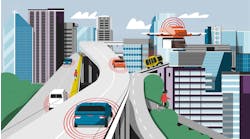Roadway intersections are fascinating things. At the core, they are the connecting piece between two byways where you find two similar, but competing interests at play—the right to pass through and the desire for minimal disruption to travel. These competing interests create opportunity for crashes when one person assumes, or sometimes simply takes, the authorization to move through the intersection ahead of the other. In short, roadway intersections are subject to human fallibility.
Over the past century, we have created many types of systems to regulate intersections, yet crashes still occur. Human fallibility persists.
According to the Federal Highway Administration (FHWA), 40% of all crashes and 21% of all fatalities are related to intersection incidents. In Arizona, on average there is a vehicle collision every four minutes. But where there is a problem, you will likely find an engineer or a team of engineers and researchers hard at work to solve it. This is where we began in Maricopa County in 2007.
In 2011, the MCDOT SMARTDrive Program was ready to develop and test CV technology in a live arterial roadway at a test bed in Anthem, Ariz.
The backstory
The Arizona Connected Vehicle Consortium (ACVC) began in 2007 as a partnership between the Maricopa County Department of Transportation (MCDOT), the Arizona Department of Transportation (ADOT), the University of Arizona (UA) and the U.S. DOT with the primary goal to research and identify how new technology applications connecting vehicles to the infrastructure (V2I) could improve safety and incident management as well as enhance traffic-signal operations and traveler information.
Within the broader ACVC framework, the MCDOT SMARTDrive Program was initiated to integrate vehicles together with Systematically Managed ARTerial (SMART) roadway systems in Maricopa County.
The initial focus was on improving emergency responder safety at intersections.
In Arizona, collisions involving a fire department vehicle or ambulance occur every four days, and the most likely place for an emergency vehicle to be involved in a collision with another vehicle is at an intersection. On average, about 30% of all firefighter fatalities are response or roadway scene related, according to the National Fire Protection Agency (NFPA).
In addition to emergency responder safety, the ACVC also set goals to improve safety for all roadway users including transit users and pedestrians. The group aimed to improve emergency response time, enhance transportation mobility and efficiency, and promote economic productivity.
With these goals in place, the MCDOT SMARTDrive Program embarked on Phase I of its program development. During this phase, which ran from 2009 to 2012, MCDOT and its partners developed and tested the connected vehicle concepts for traffic-signal operations. The Multi-Modal Intelligent Traffic Signal Systems (MMITSS) application was developed by the University of Arizona research team. It is a vehicle prioritization application that enhances traffic-signal operations through more advanced detection, smarter priority and adaptive algorithms. The tests were first conducted in a lab at the University of Arizona, then in a parking lot at MCDOT and finally at an isolated traffic signal in Maricopa County.
Participating agencies in the AZTech Regional Partnership share data through RADS.
The Anthem CV test bed
In 2011, the MCDOT SMARTDrive Program was ready to develop and test its connected vehicle technology in a live arterial roadway environment, and built a test bed in Anthem, Ariz., just north of Phoenix.
The Anthem community provided a setting where the program could work closely with the community. The master-planned community was developed in 1999 and is home to approximately 22,000 people. Anthem has several schools, fire stations, community centers and businesses. It also is situated just east of I-17. Anthem provided all of the necessary traffic patterns both in town and along I-17 to complete the desired studies.
A year later, the Anthem Connected Vehicle Test Bed was officially recognized as a Nationally Affiliated Test Bed for the U.S. DOT, making it one of the seven original connected vehicle test beds in the country. At this time, the Anthem Test Bed also was selected for MMITSS deployment by the National Connected Vehicle Pooled Fund Study (CVFPS). These two affiliations were critical to the test bed’s development and provided the needed momentum to move the research forward.
With the Anthem Connected Vehicle Test Bed ready for operational testing, the MCDOT SMARTDrive Program moved into Phase II and began developing, testing and refining the vehicle prioritization technology.
How vehicle prioritization works
The vehicle prioritization system deployed at the Anthem Test Bed enables two-way, wireless communication between vehicles and roadway infrastructure using dedicated short-range communications (DSRC). DSRC provides secure and fast messaging needed for safety and mobility applications. The communications range is approximately 300-1,000 meters.
DSRC equipment is installed in the vehicle and on the infrastructure to allow the vehicle and the infrastructure to communicate.
The DSRC reports vehicle data to the MMITSS system. Through MMITSS, vehicles are assigned a priority category, e.g., emergency vehicle, transit vehicle, freight vehicle, personal vehicle. This data is shared 10 times per second and includes a vehicle’s category, GPS positioning, speed, heading, steering wheel angle, acceleration, and braking. The MMITSS then uses the vehicle information to prioritize traffic flow and give priority, or green-light time, to those vehicle categories ranked with higher importance, including emergency vehicles and transit vehicles. The MMITSS also can prioritize between two emergency vehicles approaching the intersection at the same time at conflicting or concurrent signal-timing phases. Once the MMITSS sets the signal operation, the information is broadcast back to the vehicle using the DSRC, advising the vehicle of the priority status.
Right now, this system is currently deployed at 11 intersections in the Anthem community, and as the communications technology evolves, MCDOT plans to test other V2I communication methods.
The town of Anthem provided a setting where the SMARTDrive Program could work closely with the community.
Beyond emergency vehicles
The Anthem Connected Vehicle Test Bed has expanded its testing to include applications including a pedestrian signal crosswalk application and transit priority application.
A smartphone app that connects pedestrians to the traffic signal system is being developed and tested. The app can request a pedestrian crosswalk signal, or inform pedestrians when to cross and how to remain aligned with the crosswalk based on real-time. It is based on the SmartCross application originally developed by Savari Inc., under a grant from the U.S. DOT Small Business Innovation Research program.
The transit prioritization app allows transit vehicles to receive transit signal priority at traffic signals to promote an efficient transit system. Limited evaluation tests indicate that while using CV technology, bus travel times decreased by more than 15%. As the MCDOT SMARTDrive Program moves into Phase III, it expects to begin the full operational deployment of the vehicle prioritization technology, starting with emergency vehicles and then expanding to local school buses.
In the future, MCDOT also plans to expand the CV applications to include smarter work zones, freight vehicles and commuter vehicles. The technology also will be incorporated into the upcoming Loop 101 Mobility Partnership, a $6 million FHWA Advanced Transportation and Congestion Management Technologies Deployment (ATCMTD) grant project with ADOT and other jurisdictions in the Phoenix Metro area, aimed at developing technology to decrease congestion and improve safety on one of the Phoenix area’s most traveled freeways.
Transit prioritization allows transit vehicles to receive priority at traffic signals to promote an efficient system.
Driving into the future
V2I technology will be used to address the emergence of a new type of roadway user. This comes as the ability to work, shop and socialize remotely is touching every demographic. Today, 54% of millennials say they use social media to interact with their friends instead of “going out,” and only 69% of millennials had a driver’s license by the time they turned 19, compared to 88% of teenagers in 1983. Older generations are downsizing their homes and looking to “age in place” in communities where they can walk, cycle or take transit. There also has been an increase in telecommuting. Last year, at least 24% of all workers did some or all of their work at home.
These trends are driving demand for the expansion of transit and alternative modes of travel like shared rides and vehicles. We also are seeing more freight vehicles on the roadways, as 25% of all retail purchases are made online and that number is increasing every day.
In response, the transportation landscape is changing with a focus on alternatives that are multimodal, connected, informed, on-demand, shared and smart. Connected vehicle technology has the potential to improve safety, transit efficiency, freight delivery and pedestrian efficiency, but it comes with challenges.
Caution: challenges ahead
The enormous amount of data that could be generated by connected vehicles is almost incomprehensible. Agencies must consider the safety, security, and privacy of this data and develop technology in a way that does not compromise it. Maricopa County’s strategy is first to work in a controlled public environment, such as public fleets and transit, to test the data collection and exchange systems. This will allow MCDOT the ability to address issues and ensure systems are stable.
Agencies also need to consider who will maintain and operate the CV equipment in the future. Most universities and trade schools do not yet have the programs to supply the required skilled labor. It is important for the transportation industry to partner with universities and colleges and encourage them to offer classes to train the workforce in connected and automated vehicle technologies.
Lastly, we need champions and leaders to help steer the industry in a new direction. Not only individual leaders but agencies will be needed to create opportunities for innovation. Continued innovation cannot move forward if we do not have the right people at the table providing the momentum to move these initiatives forward.
Giving the green light
Through partnership and collaboration, the transportation industry can overcome these challenges.
Connected vehicles will require a seamless transportation system across jurisdictional boundaries. At the Anthem Test Bed, the MCDOT SMARTDrive Program partnered with Caltrans to develop an inter-operable CV system across state boundaries. The program also leverages local partnerships through the AZTech Regional Partnership, which is comprised of both private and public partners and provides support to transportation agencies in the Phoenix metropolitan area. Participating agencies share data through the Regional Archived Data System (RADS), which coordinates ITS operations in order to reduce traffic congestion and improve traveler information. AZTech also is engaged in discussions at the national level with auto manufacturers on data exchange and the use of RADS to integrate data available from connected vehicles in order to improve transportation operations and traveler information.
Twenty years ago the idea of vehicles interacting with a traffic signal was about as foreign as the idea that we might one day be able to access worlds of information from a handheld wireless telephone. Yet, as technology continues to evolve, the capability for vehicles and infrastructure to interact grows exponentially every year.
Connected vehicles and their applications offer such great potential to the future of transportation. The transportation industry is only beginning to fathom the magnitude of its possibilities. From improved mobility to vehicle prioritization, these technologies will provide seamless transportation with the flexibility to meet the ever-changing demands of our society.



